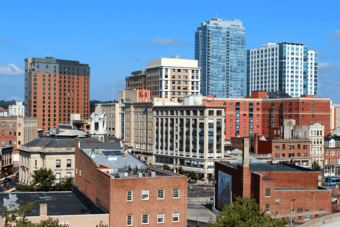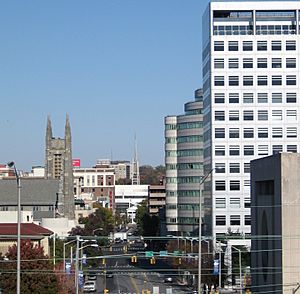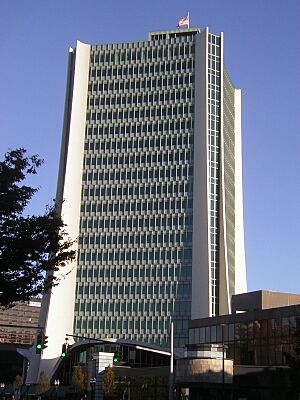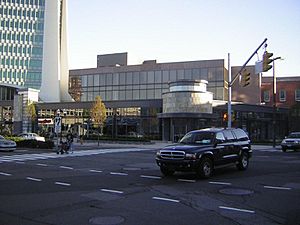Downtown Stamford facts for kids
|
Downtown Stamford Historic District
|
|

Downtown Stamford, looking west
|
|
| Location | Atlantic, Main, Bank, and Bedford Sts. (original); Roughly, Bedford St. between Broad and Forest Sts. (increase); Stamford, Connecticut |
|---|---|
| Area | 17.2 acres (7.0 ha) 3.7 acres (1.5 ha) (1984 increase) 5 acres (2.0 ha) (2003 increase) |
| Architect | Multiple |
| Architectural style | Late 19th and 20th Century Revivals, Late Victorian, Commercial Vernacular, Late 19th And 20th Century Revivals, Modern Movement |
| NRHP reference No. | 83003502 (original) 85000311 (increase 1) 02001744 (increase 2) |
Quick facts for kids Significant dates |
|
| Added to NRHP | October 6, 1983 |
| Boundary increases | February 21, 1985 January 31, 2003 |
Downtown Stamford is the busy center of Stamford, Connecticut. It's a lively place with lots of shops, a big mall, and even a university campus. Many large companies have their main offices here. You'll also find hotels, restaurants, and tall apartment buildings.
Since the year 2000, Downtown Stamford has grown a lot. Many new high-rise buildings have been built. New parks, like Mill River Park, have also been added. There are also new homes, including tall apartment buildings. The city is always working to make the area even better.
Contents
Where is Downtown Stamford?
Downtown Stamford is located in the middle of the city. To the east is the West Side, separated by the Mill River. South of Downtown are the South End and Shippan. These areas are separated by a highway and railroad tracks.
To the west are the East Side and Glenbrook. North of Downtown are areas like Newfield and Belltown. Bull's Head, a shopping area, is just north of Downtown.
What is the Downtown Stamford Historic District?
The Downtown Stamford Historic District is a special area. It was added to the National Register of Historic Places in 1983. This means its buildings are important to history. The district started with 56 buildings. They showed off different old building styles. These included Late 19th and 20th Century Revivals, Late Victorian, and Commercial Vernacular.
The district has grown twice since then. In 1985, more buildings were added. These included older shops and warehouses. In 2002, even more buildings joined the district. This added styles like Late Gothic Revival and Art Deco. Today, the historic district covers most of the southern part of Downtown. It helps protect many old and unique buildings.
Cool Buildings in Downtown Stamford
Downtown Stamford has many interesting buildings. Some are very tall, while others have unique designs.
Tall Buildings (High-rises)
Recently, many new tall buildings have been built here.
- Trump Parc Stamford
This building was finished in 2008. It has 35 stories and is a condominium tower. It is currently the tallest building in Stamford. It has 170 homes inside.
- One Landmark Square
This skyscraper was built in 1973. It has 21 stories and was once the tallest building between New York City and New Haven. It is still the second-tallest building in Stamford. It's known for its unique look.
- Highgrove Condominium Residences
Finished in 2009, this building has 17 stories. It is the third-tallest building in Stamford. It offers many homes for people.
Buildings by Victor Bisharat
Many special buildings in Downtown Stamford were designed by Victor Bisharat. He was an architect from Jordan.
- St. John's Towers
These three buildings were finished in 1971. They are 17 stories tall and have a unique round shape.
- One Stamford Forum
This building looks like an upside-down pyramid. It has 13 floors and is 196 feet (60 meters) high. It used to be called the "GTE building." It has a special indoor garden inside.
Other Interesting Buildings
- One Atlantic Street
This building was finished in 1931. It has cool Art Deco designs inside and out. For a long time, it was the tallest building in Stamford.
- University of Connecticut Campus
This large building has a green glass front. It was designed by Perkins Eastman. It's where students attend classes.
- Old Town Hall
This beautiful building was built between 1905 and 1907. It used to be where the city government worked. It's a great example of Beaux Arts style.
- The "Fish Church"
Also known as the First Presbyterian Church, this church was designed by Wallace K. Harrison. He also designed the United Nations buildings. It opened in 1958. The church is shaped like a fish, and its stained glass windows are amazing. They have over 20,000 pieces of colored glass. People say being inside is like being "inside a jewel."
- Gurley Building
Built in 1924, this is a tall, narrow building with eight stories. It's located at the corner of Main Street and Atlantic Street.
- Weed's Hall
This five-story building was built in 1886. It's special because it's the only building in Stamford with a cast iron front.
- Ferguson Library
This two-story brick building was built in 1910. It has a Georgian Revival style. It's a place where people can read and learn.
- 15 Bedford Street
This two-story commercial building was built in 1932. It features an Art Deco style.
- Library Apartments
Built in 1930, this three-story building is located at 65 Bedford Street.
Future Buildings
- Ritz-Carlton Stamford
This is a planned hotel and apartment complex. It will have two very tall towers, each 39 stories high. Once built, they will be the tallest buildings in the city. The project also includes shops.
Mill River Park
Mill River Park is a lovely green space in Stamford. It separates Downtown from the West Side. There are big plans to make the park even better. An $8.5 million project is underway. This project will make the river narrower. This will create more space for the park.
The plans include adding fun things like a carousel, a fountain, and an ice rink. There will also be trails to connect to other parks. Removing a dam in the river will help fish swim up from Long Island Sound.
The park is also famous for its cherry trees. These trees were a gift to the city in 1957. They were given by Junzo Nojima, a man from Japan who lived in Stamford. He even watered the trees himself to make sure they grew. Every year, the city celebrates this gift on Arbor Day.
Fun Events in Downtown Stamford
Downtown Stamford is a hub for exciting events! From June to December, there's always something happening. You can see amazing sculptures on display. There are outdoor concerts like "Alive@Five" and "Jazz up July" in Columbus Park. You can also find Arts & Crafts fairs on Bedford Street.
One of the most popular events is a giant helium balloon parade. It marches right through Downtown! These events bring thousands of people to the area. It's a great way to have fun and see what Downtown Stamford has to offer.
Pictures
Images for kids
-
One Landmark Square, the second tallest building in Stamford.




























